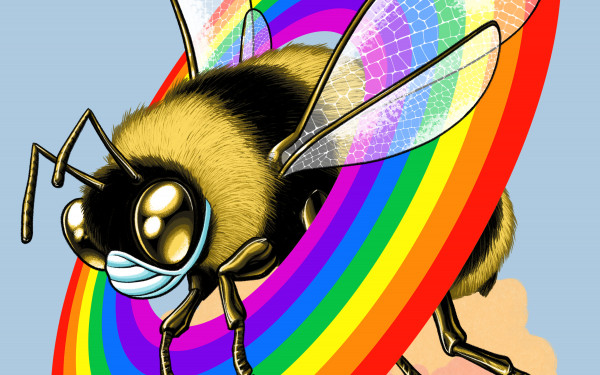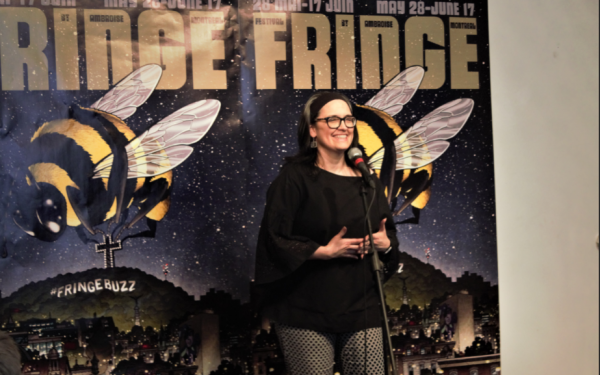Theatre Review: “Don’t Read the Comments” Shows the Messy Side of #MeToo
A Fringe Festival Performance That Uses Bouffon To Make a Point
“Don’t read the comments.”
It’s often pretty sound advice. Everyone knows that it’s in the comments section of online articles that the trolls congregate en masse to spew their inflammatory drivel. Bothering to sift through it will give you little more than a headache and a fear for the fate of humanity. This is true most of all when the article deals with controversial, sensitive or personal subjects. Like, for example, the #metoo movement.
And it’s this colossal issue and the many differing opinions around it that Don’t Read the Comments, a show in this year’s Fringe Festival, tries to take on.
The show runs till June 17 in the small, intimate Studio MMP venue, with 10 shows total over the two weeks of the festival. It’s set on the stage of a talk show in which host Wendy Winfrey invites three guests to discuss the confusing subject of sexual assault, with very messy results. The characters, portrayed in the clown style of bouffon, show us absurd but often very real points of view about consent, responsibility, societal expectations, and the grey areas that come up after experiencing uncomfortable sexual encounters⎯the kind you can’t seem to put a name on.
“Bouffons are a form of clown that push the limits and the boundaries,” explained playwright and director Sarah Segal-Lazar. “They really do hold up this very grotesque mirror to society so what they’re doing is not false, it’s just greatly exaggerated.”
Throughout the performance the audience watches as Grace Haverford, a young fourth wave feminist studying survivor politics at the “Simone de Boudoir” institute, “woke bro” feminist youtuber Geoffrey “Tripp” Jeffrey, and older, republican senator Cindy Nancy Cindy attempt to navigate the murky waters that make up the conversations around consent in this post-#metoo climate. Their discussions, through talk show segments with titles like ‘Act it Out!’ and ‘Did That Really Happen?’ lead to absurd and often uncomfortable results.
Segal-Lazar said that for her, the use of bouffon was the only way she could make sense of the often outlandish perspectives around sexual violence, and the confusing sexual encounters that are far from black-and-white.
“Once I knew that I was using bouffons I thought it would be really interesting to see how much text from the media, how many articles that have been written actually match what we consider the horrific, grotesque boundary-pushing art form of bouffon.”
She explained that 80 per cent of the dialogue in the piece is pulled from articles discussing the subject.
“I thought it was really interesting that you hear the same words coming out of their mouths as that are written on pages of The New York Times or The Washington Post and no one is sitting in [the audience] thinking […] ‘That’s from a respected journalist or a respected politician.’ They’re thinking ‘They came up with some really messed up material.’”
Segal-Lazar said that the inspiration for the piece came specifically from seeing people’s unwillingness to engage with the #metoo movement and the conversations that came from it. In response, she wrote a piece that she hopes will force discussions.
“I talk about this piece as an appetizer and I say in my dream world, you see this show and then you leave and you have a conversation with your friends and you go home and you ask yourself questions.”
Despite the humour of the show, it is at times hard to watch. This use of bouffon to address such a deeply personal issue is reminiscent of the theatre of alienation, theatre that makes you uncomfortable with it and with yourself. But the point that the show makes is that your alienation cannot be an excuse to not participate in the hard conversations.
The result for the audience is sometimes off-putting, but that is necessary: we need to see these grotesque characters navigate consent, the sexual encounters tainted with pressuring, persistence, misread non-verbal cues and so on to give us insight on how to do so on our own. In fact, the piece forces the audience to participate, in a way that might feel troublesome but further pushes the point that there is no other alternative.
“The point is, you have to participate in this conversation,” said Segal-Lazar. “You don’t get to sit in a chair and watch the world burn down around you. You’ve either got to put water on the flame or add gasoline, but you have to participate.”
“The point is, you have to participate in this conversation.You don’t get to sit in a chair and watch the world burn down around you. You’ve either got to put water on the flame or add gasoline, but you have to participate” ⎯Sarah Segal-Lazar
And in focusing on the “grey areas” of consent, the piece acknowledges the extreme power they can hold over us, to understand how two people who have dealt with similar confusing occurrences can experience them in wildly different ways.
“You should never feel comfortable pushing someone over their limits,” said Segal-Lazar. “That’s not acceptable whatsoever, but it’s more that as the people on the receiving end, what does it mean to not know what happened to you? And as the listener, like for me when I’m helping friends through things, what does it mean to watch them not know?”
The piece doesn’t pretend to have any answers, but it is asking questions, and trying to make sense of a topic that might be impossible to make sense of at all. In focusing on those encounters that toe the line of abuse, it puts a spotlight on the kinds of experiences that frequently aren’t talked about.
As Segal-Lazar said, “It’s super messy, and that’s what we talk about in the show: this is a messy subject and there’s no way to navigate it cleanly.”




